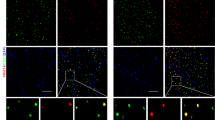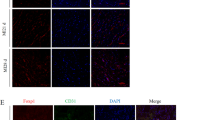Abstract
Purpose. Gene therapy using vascular endothelial growth factor (VEGF) is a new potential treatment of ischemic disease. To be safe and effective, VEGF expression should be enhanced locally in ischemic tissue. In this study, we identified the cis-regulatory element for the hypoxia induction of the RTP801 promoter. In addition, pRTP801-VEGF was evaluated as a therapeutic plasmid in vitro.
Methods. The cis-regulatory element for hypoxia induction was identified by deletion and mutation analyses. Antisense oligonucleotide co-transfection assay was performed to evaluate the role of Sp1. pRTP801-VEGF was constructed by the insertion of the RTP801 promoter into the VEGF plasmid. The hypoxia-inducible expression of VEGF was evaluated by in vitro transfection assay.
Results. In luciferase assay, the region between -495 and -446 was responsible for the hypoxia-induced transcription. The mutation of the Sp1 site in this region reduced hypoxia-induced transcription. In addition, co-transfection with antisense Sp1 oligonucleotide suggests that hypoxia induction of the RTP801 promoter is mediated by Sp1. In vitro transfection showed that pRTP801-VEGF had higher VEGF expression than pEpo-SV-VEGF. In addition, VEGF expression by pRTP801-VEGF was induced under hypoxia.
Conclusions. With strong basal promoter activity and induction under hypoxia, pRTP801-VEGF may be useful for gene therapy for ischemic disease.
Similar content being viewed by others
references
M. Azrin. Angiogenesis, protein and gene delivery. Br. Med. Bull. 59:211-215 (2001).
J. Kastrup, E. Jorgensen, and V. Drvota. Vascular growth factor and gene therapy to induce new vessels in the ischemic myocardium. Therapeutic angiogenesis. Scand. Cardiovasc. J. 35:291-296 (2001).
J. M. Isner. Myocardial gene therapy. Nature 415:234-239 (2002).
J. F. Symes, D. W. Losordo, P. R. Vale, K. G. Lathi, D. D. Esakof, M. Mayskiy, and J. M. Isner. Gene therapy with vascular endothelial growth factor for inoperable coronary artery disease. Ann. Thorac. Surg. 68:836-837 (1999).
P. R. Vale, D. W. Losordo, C. E. Milliken, M. Maysky, D. D. Esakof, J. F. Symes, and J. M. Isner. Left ventricular electromechanical mapping to assess efficacy of phVEGF(165) gene transfer for therapeutic angiogenesis in chronic myocardial ischemia. Circulation 102:965-974 (2000).
C. Sylven, N. Sarkar, A. Ruck, V. Drvota, S. Y. Hassan, B. Lind, A. Nygren, Q Kallner, P. Blomberg, J. van der Lindern, D. Lindblom, L. A. Brodin, and K. B. Islam. Myocardial Doppler tissue velocity improves following myocardial gene therapy with VEGF-A165 plasmid in patients with inoperable angina pectoris. Coron. Artery Dis. 12:239-243 (2001).
D. G. Affleck, L. Yu, D. A. Bull, S. H. Bailey, and S. W. Kim. Augmentation of myocardial transfection using TerplexDNA: a novel gene delivery system. Gene Ther. 8:349-353 (2001).
M. Lee, J. Rentz, S. Han, D. A. Bull, and S. W. Kim. Water soluble lipopolymer as an efficient carrier for gene delivery to myocardium. Gene Ther. 10:585-593 (2003).
E. Brogi, G. Schatteman, T. Wu, E. A. Kim, L. Varticovski, B. Keyt, and J. M. Isner. Hypoxia-induced paracrine regulation of vascular endothelial growth factor receptor expression. J. Clin. Invest. 97:469-476 (1996).
J. S. Lee and A. M. Feldman. Gene therapy for therapeutic myocardial angiogenesis: a promising synthesis of two emerging technologies. Nature Med. 4:739-742 (1998).
M. L. Springer, A. S. Chen, P. E. Kraft, M. Bednarski, and H. M. Blau. VEGF gene delivery to muscle: potential role for vasculogenesis in adults. Mol. Cell 2:549-558 (1998).
R. J. Lee, M. L. Springer, W. E. Blanco-Bose, R. Shaw, P. C. Ursell, and H. M. Blau. VEGF gene delivery to myocardium: deleterious effects of unregulated expression. Circulation 102:898-901 (2000).
M. Lee, J. Rentz, M. Bikram, S. Han, D. A. Bull, and S. W. Kim. Hypoxia inducible VEGF gene delivery to ischemic myocardium using water-soluble lipopolymer. Gene Ther. 10:1535-1542 (2003).
H. Su, J. Arakawa-Hoyt, and Y. W. Kan. Adeno-associated viral vector-mediated hypoxia response element-regulated gene expression in mouse ischemic heart model. Proc. Natl. Acad. Sci. USA 99:9480-9485 (2002).
T. Shoshani, A. Faerman, I. Mett, E. Zelin, T. Tenne, S. Corodin, Y. Moshel, S. Elbaz, A. Budanov, A. Chajut, H. Kalinski, I. Kamer, A. Rozen, O. Mor, E. Keshet, D. Leshkowitz, P. Einat, R. Skaliter, and E. Feinstein. Identification of a novel hypoxia-inducible factor 1-responsive gene, RTP801, involved in apoptosis. Mol. Cell. Biol. 22:2283-2293 (2002).
G. L. Wang, B.-H. Jiang, E. Rue, and G. L. Semenza. Hypoxia-inducible factor 1 is a basic-helix-loop-helix-PAS heterodimer regulated by cellular O2 tension. Proc. Natl. Acad. Sci. USA 92:5510-5514 (1995).
R. H. Wenger and M. Gassmann. Oxygen(es) and the hypoxia-inducible factor-1. Biol. Chem. 378:609-616 (1997).
B.-H. Jiang, E. Rue, G. L. Wang, R. Roe, and G. L. Semenza. Dimerization, DNA binding, and transactivation properties of hypoxia-inducible factor 1. J. Biol. Chem. 271:17771-17778 (1996).
G. L. Semenza, B. H. Jiang, S. W. Leung, R. Passantino, J. P. Concordet, P. Maire, and A. Giallongo. Hypoxia response elements in the aldolase A, enolase 1, and lactate dehydrogenase A gene promoters contain essential binding sites for hypoxia-inducible factor 1. J. Biol. Chem. 271:32529-32537 (1996).
G. L. Wang and G. L. Semenza. General involvement of hypoxia-inducible factor 1 in transcriptional response to hypoxia. Proc. Natl. Acad. Sci. USA 90:4304-4308 (1993).
Q. Xu, Y.-S. Ji, and J. F. Schmedtje Jr. Sp1 increases expression of cyclooxygenase-2 in hypoxic vascular endothelium. Implications for the mechanisms of aortic aneurysm and heart failure. J. Biol. Chem. 275:24583-24589 (2000).
L. E. Huang, J. Gu, M. Schau, and H. F. Bunn. Regulation of hypoxia-inducible factor 1α is mediated by an O2-dependent degradation domain via the ubiquitin-proteasome pathway. Proc. Natl. Acad. Sci. USA 95:7987-7992 (1998).
T. Sanchez-Elsner, L. M. Botella, B. Velasco, C. Langa, and C. Bernabeu. Endoglin expression is regulated by transcriptional cooperation between the hypoxia and transforming growth pathways. J. Biol. Chem. 277:43799-43808 (2002).
Author information
Authors and Affiliations
Corresponding author
Rights and permissions
About this article
Cite this article
Lee, M., Bikram, M., Oh, S. et al. Sp1-Dependent Regulation of the RTP801 Promoter and Its Application to Hypoxia-Inducible VEGF Plasmid for Ischemic Disease. Pharm Res 21, 736–741 (2004). https://doi.org/10.1023/B:PHAM.0000026421.09367.b3
Issue Date:
DOI: https://doi.org/10.1023/B:PHAM.0000026421.09367.b3




